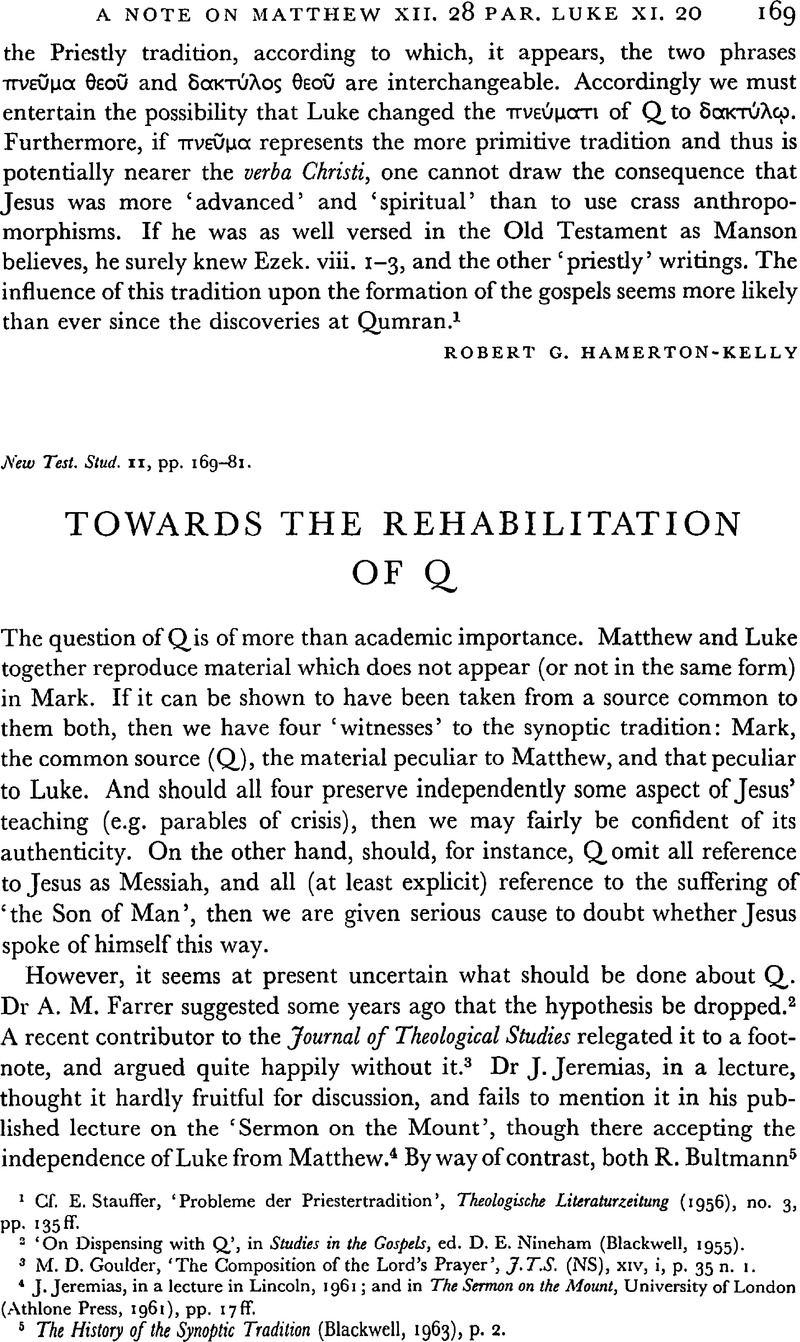Article contents
Towards the Rehabilitation of Q
Published online by Cambridge University Press: 05 February 2009
Abstract

- Type
- Short Studies
- Information
- Copyright
- Copyright © Cambridge University Press 1965
References
page 169 note 2 ‘On Dispensing with Q’, Studies in the Gospels, ed. D. E. Nineham (Blackwell, 1955).
page 169 note 3 Goulder, M. D., ‘The Composition of the Lord's Prayer’, J.T.S. (NS), XIV, i, p. 35 n. 1.Google Scholar
page 169 note 4 Jeremias, J., in a lecture in Lincoln, 1961; and in The Sermon on the Mount, University of London (Athlone Press, 1961), pp. 17 ff.Google Scholar
page 169 note 5 The History of the Synoptic Tradition (Blackwell, 1963), p. 2.Google Scholar
page 170 note 1 Jesus of Nazareth (Hodder and Stoughton, 1960), p. 215.Google Scholar
page 170 note 2 The Earliest Records of Jesus (Blackwell, 1962), p. 14.Google Scholar
page 170 note 3 Op. cit. p. 56; present writer's parentheses.Google Scholar
page 170 note 4 The Four Gospels (Macmillan, 1924).Google Scholar
page 170 note 5 Dr Farrer claimed that his was no hypothesis, and that Q was merely hypothesis (op. cit. p. 66); but that Luke used Matthew must in the nature of the case remain as much an hypothesis as the one-time existence of Q.Google Scholar
page 170 note 6 In what follows these will be compared as they stand in Lietzmann, A. Huck-H., Synopsis of the First Three Gospels, English ed. Cross, F. L. (Blackwell, 1951)Google Scholar; cp. B. H. Throckmorton for a version of this synopsis with the R.S.V. text (Nelson).
page 170 note 1 Its significance is noted without further explanation by Beare, F. W., op. cit. p. 102Google Scholar; cf. Studies in the Synoptic Problem, ed. Sanday, W. (Clarendon, 1911), pp. 53 and 71.Google Scholar
page 177 note 1 Cf. Conzelmann, H., The Theology of St Luke (Faber, 1960), pp. 22ff.Google Scholar He points out that the identification is however there in Luke i. 17.
page 177 note 2 It is assumed that the parallels in Matt, . xxv. 13,Google Scholar 14, 15b to the end of Mark's Apocalyptic discourse, xiii. 33–7 (to which Matthew offers no previous parallels), allow it to be taken that right into this block of material Matthew was still consciously conflating his material with Mark. He omitted Mark xiii. 33–7, knowing that his other parabolic material would only repeat these verses of Mark. Certainly at xxiv. 42 he seems still directly to be quoting Mark (xiii. 35 a). That is, this is still material of the sort we have been considering up to now.
page 177 note 3 Unless γάρ in Luke, xxi. 8 and 9,Google Scholar and ἕως ἂν in Luke xxi. 32 be taken as evidence to the contrary.
page 177 note 4 Op. cit. p. 84.Google Scholar
page 179 note 1 Op. cit. p. 62.Google Scholar
page 180 note 1 Dr Farrer can suggest only two instances of Luke's ‘transcription of…Markan sentences embedded in Matthaean discourses’: the Beelzebul controversy, and the sermon on the Little Ones (op. cit. p. 83). We have suggested above that Luke seems to have left only ‘Matthaean’ sentences, and no obvious Markan ones, in the former discourse; and the latter is a further illustration of Luke's independence of Matthew at just this point of Matthew's marriage of similar material in Mark and his other source (s). In Matt, . xviii. 6–9,Google Scholar to a Markan saying about causes of stumbling is appended a complete saying on the same subject, the necessity of scandala, and ‘woe to the man through whom the scandalon comes’. This is the only context in Mark where scandala are discussed in these terms, and here it is at length. Luke has a similar saying to that in Matthew, and of course, if he is to add it at all, he will add it here. In fact, he uses it to introduce the Markan saying, and omits all of the words of Mark that Matthew reproduces, save περι τον τράχηλον αυτου and εις τήν θάλσσαν, which are anyway the irreducible minimum of the saying. He makes his conflation with no sign at all of any dependence on Matthew for it.
page 180 note 2 Grant, R. M. and Freedman, D. N., The Secret Sayings of Jesus (Collins, Fontana, 1960).Google Scholar
page 181 note 1 Though he may have received his material independently of our Gospels (and so, quite early?), he includes material in all the synoptists, with perhaps some echoes of the Fourth Evangelist added later. See K. Grobel, ‘How Gnostic is the Gospel of Thomas?’, N.T.S. VIII, 4 (July 1962), 367ff.Google Scholar; Brown, R. E., ‘The Gospel of Thomas and St John's Gospel’, N.T.S. IX, 2 (January 1963), 155ff.Google Scholar; also Brown, J. P., ‘The Form of “Q” known to Matthew’, N.T.S. VIII, 1 (October 1961), esp. 38ff.Google Scholar
page 181 note 2 See Brown, J. P., op. cit.Google Scholar The present writer would not, even to meet Dr Farrer's challenge, be willing to attempt to work out the precise extent of Q (Dr J. P. Brown does attempt this speculation), and would only treat the passages where Matthew and Luke are very largely in agreement, say 70 per cent and over, as Q, where this was to serve as the basis for a further argument. However, from their treatment of Markan parables (e.g. the Sower) Matthew and Luke might well be expected to differ largely in their use of Q parables (e.g. the Pounds-Talents) and these might need to be judged separately.
It is perhaps worth noting, even at this late point, that in this discussion of Dr Farrer's hypothesis, I have joined him in assuming for the moment without argument that both Luke and Matthew had before them a copy of Mark much as we have it.
- 5
- Cited by




